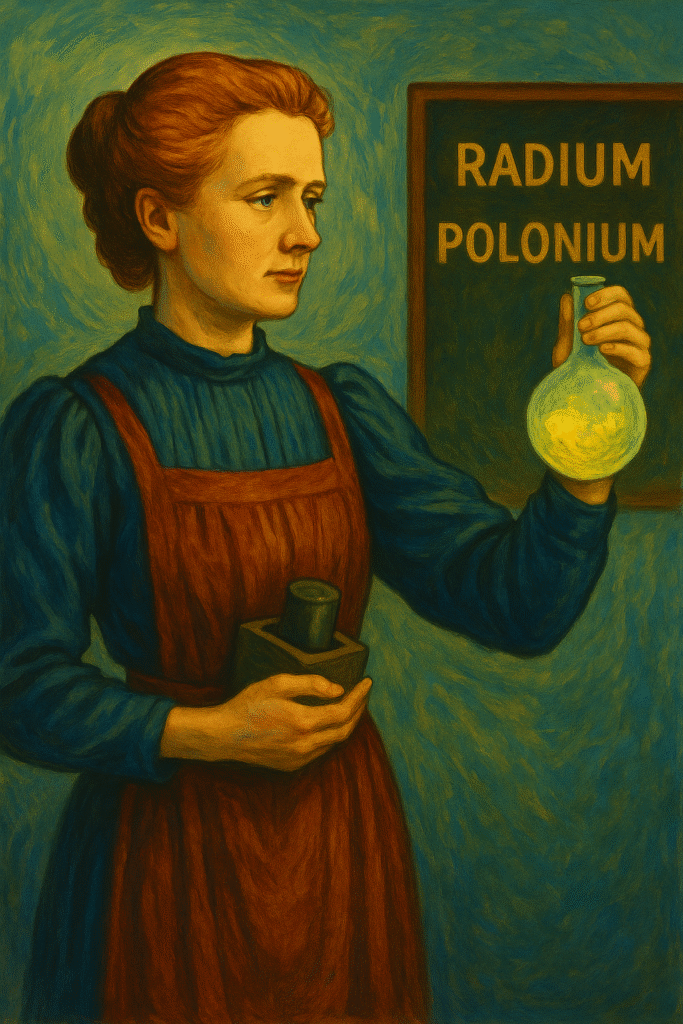Introduction: A Spark that Ignited Change
Marie Curie’s legacy is nothing short of revolutionary, not only for the scientific advancements she championed but also for the new horizons she opened for women in academia and beyond. Her groundbreaking discoveries in radioactivity reshaped scientific conventions and left an enduring impact that continues to resonate in modern medicine and technology. A pioneer of her time, Curie’s work laid a foundation upon which countless women in STEM fields have built successful careers. As we delve into her life and achievements, Curie emerges as a formidable figure whose influence reaches far beyond her own era.
Early Life: The Roots of a Genius
Born Maria Skłodowska in 1867 in Warsaw, Poland, Curie’s early life was shaped by a persistent pursuit of education and a deep-seated passion for science. In a country where opportunities for women were limited, she excelled academically, driven by an insatiable curiosity and a resilient spirit. Influenced by her father, an educator and advocate for Polish independence, young Maria developed an aptitude for mathematics and science. Her quest for knowledge led her to Paris, France, where she enrolled at the Sorbonne. This move not only marked a pivotal step in her academic journey but also set the stage for a seismic shift in the scientific community.
The Radioactivity Discovery: Unveiling a New Era
Marie Curie’s exploration into radioactivity, a term she coined, heralded a transformative period in physics and chemistry. Together with her husband Pierre Curie, she meticulously isolated the elements polonium and radium, unraveling the mysterious emissions that formed the basis of radioactivity. This profound discovery not only expanded the scientific understanding of atomic structures but also laid the groundwork for significant advancements in medical treatments, particularly cancer therapy. The Curies’ dedication and innovative methodologies revealed the immense potential of radioactivity, promising a plethora of applications in both scientific disciplines and societal health.
The Double Nobel Prize: An Unprecedented Achievement
A testament to her unparalleled contributions, Marie Curie became the first person to be honored with Nobel Prizes in two different scientific fields. In 1903, she and Pierre, alongside Henri Becquerel, were awarded the Nobel Prize in Physics for their joint research on radiation phenomena. Her second Nobel Prize in Chemistry, awarded in 1911, acknowledged her services to the advancement of chemistry through the discovery of radium and polonium. Such recognition was unprecedented, solidifying Curie’s place in history as a pioneer whose work transcended traditional gender boundaries in science.
Challenges as a Female Scientist: Breaking Barriers
Navigating a male-dominated field, Curie’s path was fraught with obstacles, ranging from gender discrimination to societal scepticism. Her groundbreaking work in radioactivity often met with dismissal due to prevailing biases against women in academic circles. Undeterred, Curie’s perseverance carved a path through prejudice, proving her mettle in a rigorous world that rarely acknowledged the intellectual prowess of women. Her triumph over these adversities not only advanced her own career but also paved the way for successive generations of female scientists, inspiring them to pursue their ambitions despite formidable resistance.
Curie’s Legacy: Inspiring Future Female Scientists
Today, Marie Curie’s legacy is indelibly etched in the landscape of science and education. Statistics show a growing number of women pursuing careers in STEM fields, a testament to Curie’s enduring influence. The road she paved encourages modern female scientists to challenge norms and make critical contributions to their fields. Her story serves as a beacon of possibility, reminding us of the power of perseverance and the impact of visionary leaders who change the course of history.
Collaboration and Contribution to Science: The Power of Teamwork
Marie Curie’s collaboration with her husband Pierre exemplifies the strength of teamwork in scientific research. Their partnership, marked by synergy and mutual respect, was instrumental in the breakthroughs that marked the dawn of the nuclear age. Within this dynamic, both Curies brought unique skills to the table, showcasing the profound impact of collaborative efforts in achieving scientific advancement. Such partnerships remain integral to scientific progress today, underscoring the importance of working together towards common goals.
The Impact of Radioactive Materials in Medicine
The tangible benefits of Curie’s work on radioactivity are most evident in the field of medicine, particularly in the development of radiotherapy for cancer treatment. The use of radium in treating malignancies has revolutionized medical practice, offering hope to countless patients worldwide. Advances in technology have further harnessed the properties of radioactive materials, enabling more targeted and effective treatments. This evolution continues to underscore the enduring influence of Curie’s pioneering research on contemporary healthcare.
Marie Curie in Education: A Model for Future Generations
Incorporating Marie Curie’s story into educational curricula serves as an inspiration for students everywhere. Her achievements exemplify the rewards of relentless curiosity and dedication to one’s goals. Educators can draw on Curie’s legacy to encourage students to explore the sciences, demystifying subjects like physics and chemistry by linking them to her groundbreaking work. Through storytelling and historical context, Curie’s life becomes a narrative that resonates with the aspiring minds of future generations.
Feminism in Science: Curie’s Pioneering Role
At the intersection of science and social progress, Marie Curie’s career embodies the principles of feminism in a field once unwelcoming to women. Her perseverance against systemic gender bias laid the groundwork for feminist movements within scientific communities, empowering women to assert their rightful place in STEM. Curie’s story remains a powerful illustration of how gender equality in professional arenas can be achieved, serving as an enduring symbol of resilience and capability.
Scientific Advancements: Curie’s Influence on Physics and Chemistry
Curie’s research in radioactivity spurred significant advancements in both physics and chemistry, catalyzing a deeper understanding of atomic behavior. Her findings on the properties of radioactive elements fundamentally altered scientific paradigms, facilitating innovations that continue to evolve today. In areas ranging from nuclear energy to advanced medical imaging technologies, the ripple effects of her work manifest in varied and profound ways, proving the timeless relevance of her contributions.
The Historical Context of the Nobel Prize: Curie’s Place in History
Within the storied history of the Nobel Prize, Marie Curie’s recognition stands as a monumental achievement, marking a pivotal moment for women in science. This accolade not only celebrated her achievements but also symbolized the possibilities that await those who dare to challenge conventional constraints. Curie’s recognition by such a prestigious institution paved the way for future generations of female laureates, reinforcing the notion that remarkable intellect knows no gender.
The Importance of Role Models in STEM
Role models like Marie Curie play an essential role in shaping the aspirations of young students, particularly those considering careers in STEM. Research underscores the influence of such figures in motivating individuals to pursue education and careers once deemed inaccessible. Celebrating contemporary female scientists who draw inspiration from Curie helps sustain that legacy, propelling new waves of innovators equipped to address the scientific challenges of tomorrow.
Conclusion: A Lasting Impact
Marie Curie’s achievements extend far beyond her own groundbreaking scientific discoveries. Her perseverance in the face of adversity and her monumental contributions to science have secured her legacy as an icon of empowerment and innovation. Her story inspires countless generations to pursue passions fearlessly, reminding us of the boundless possibilities within the nexus of science and society.
For those eager to delve deeper into the remarkable world of influential women in science, consider exploring biographies, documentaries, and academic articles that further illuminate their enduring impacts.


